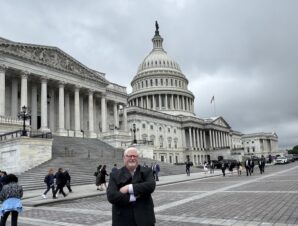 Dain Hansen is vice president of Government Relations, The IAPMO Group. He lends his frequent perspective of Capitol Hill, and the plumbing industry.
Dain Hansen is vice president of Government Relations, The IAPMO Group. He lends his frequent perspective of Capitol Hill, and the plumbing industry.
Pricey Water Bills Fix Could Mimic Successful Energy Program. Subsidizing water bills for low-income families may be more difficult than a similar successful program for energy, but that’s the road map a bipartisan group of lawmakers is exploring. The nature of the water industry—with tens of thousands of municipal-owned water suppliers that often serve 1,000 people or fewer—could make it far more difficult to implement than in the more consolidated power sector, the water industry cautions. Sen. Ben Cardin (D-Md.), one of the lawmakers working on the legislation, said many in Congress are hearing from their constituents that water and sewer bills are beginning to crowd out other items from their household budget. Cardin has said the issue really hit home for him when he was campaigning for a local candidate in Baltimore recently. “Every door I knocked on, they were asking me about their water bills—every door,” he said. “It’s obviously an essential utility and they just can’t afford it.” The bill Cardin is crafting with Sen. Roger Wicker (R-Miss.) and Rep. Marcia Fudge (D-Ohio) is modeled on a program at the Department of Health and Human Services that subsidizes energy bills in low-income areas. It would establish a five-year pilot that would give grants to 32 water utilities across the country to establish low-income assistance programs there. Cardin and Wicker first introduced the bill in the Senate late last year. Cardin said his strategy for this year is to attach the measure to a larger piece of legislation, although it’s possible it could pass on its own, suggests Hansen.
US-China Trade Negotiations. US-Chinese negotiators met in Washington this week as part of an effort to find agreement on their trade disputes by March 1. Limited progress was expected in this week’s talks, and our judgment of the results are in line with those expectations despite the positive talk from the White House following the negotiations. There will be growing anticipation of a final deal later this month, particularly if a potential meeting between President Trump and Chinese Premier Xi takes place, as expected. If a deal is struck by March 1, it will not be a far-reaching agreement that will address the myriad issues that have divided the US and China, particularly structural issues embedded in China’s trading and economic policies. That type of deal will require more time to negotiate – beyond March 1 – and is still not certain even then. It is likely President Trump will seek a more comprehensive agreement – much more than an increase in Chinese purchases of US agriculture and other products. If such an agreement needs a deadline extension beyond March 1, the question is whether there will be increased US tariffs imposed then. This will depend on the pace of progress in the negotiations and the personal Trump-Xi dynamics from their likely meeting. Due to our belief that the Chinese will be slow to make commitments in areas of importance to the US, do not rule out increased tariffs after March 1. While many are confident these negotiations will eventually produce a final deal between the two countries later this year, our sense is that progress will occur slowly and only after more pain is afflicted, poses Hansen.
White House Looks To Move Pipelines Forward. The White House is considering new executive orders that would weaken states’ authority to block energy projects and would help speed the construction of pipelines, according to sources familiar with the matter. Possible actions include changing Obama-era draft guidance for complying with a section of the Clean Water Act as a way to hinder state governors who have used the law to oppose energy projects, according to a person with knowledge of the discussions. The potential executive orders wouldn’t address one of the the oil and gas industry’s main complaints: tariffs on imported steel that executives say hamper growth. Any new executive orders, which could be part of a broader, long-delayed infrastructure plan, would likely draw pushback from Democrats like New York Gov. Andrew Cuomo as well as Republican state leaders who are wary of ceding power to protect their rivers and streams to the federal government. Trump has pledged to drive “U.S. energy dominance” abroad, capitalizing on the decade-long surge in U.S. oil and gas production that has lifted output to record levels. The sector has remained a bright spot in an economy that experts say may be in danger of dipping into recession. U.S. companies have opened the spigots on oil shipments since the ban on exports was lifted in 2015, and the U.S. has become one of the leading global shippers, says Hansen.



